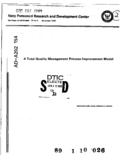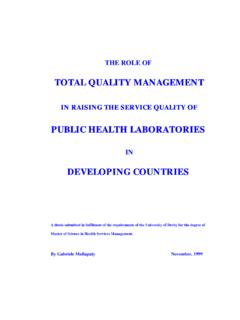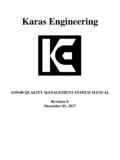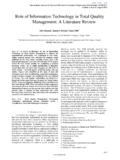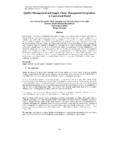Transcription of Asset Management: Phase II Total Productive …
1 A Maintenance PhilosophyAsset management : Phase IITotal Productive Maintenance1. TPM definitionzA company-wide team-based effort to build quality intosystems and to improve overall Asset effectivenesszTotalyall employees are involvedyit aims to eliminate all accidents, defects and systemproblemszProductiveyactions are performed while maintaining system integrityytroubles for system are minimizedzMaintenanceykeep in good conditionyrepair, clean, clear, lubricate1. TPM definitionzTPM combines the traditionally Americanpractice of preventive maintenance with TotalQuality Control and Total Employee Involvementto create a culture where all employees developownership of their equipment and operatingsystems and become full partners withEngineering and management to assureequipment and systems operate properly andeffectively Origins of TPMzDr. Deming introduced statistical analysis and used theresulting data to control quality during manufacturing(TQM)zSome general concepts of TQM did not work well in themaintenance environmentzThe need to go further than preventive maintenancewas quickly recognized by those companies who werecommitted to TQMzMaintenance became an integral part of TQM in theearly 90 s3.
2 TPM principleszIncrease Overall Asset Effectiveness (OAE) -Increase Asset utilizationzImprove existing planned maintenance systemszThe employee who uses the equipment most isthe best condition monitorzProvide training to upgrade operations andmaintenance skillszInvolve everyone and utilize cross-functionalteamwork3. TPM principleszMajor Equipment and ToolsyLNG and Propane Plant Equipment and SystemsyDistribution and Transmission LinesySCADA SystemsyServicesyMeters and RegulatorsyCity GatesyDistrict Regulator StationsyRectifiers and Corrosion Control Equipment3. TPM principleszMajor Equipment and ToolsyVehiclesyBackhoesyLifting EquipmentyTapping and Stopping EquipmentyShoring EquipmentyPipe HornsyGas DetectorsySqueezers3. TPM principleszMajor Equipment and ToolsyDiaphragm PumpsyArc Welder(s)yElectrofusion MachinesyLight SetsySCBAsyFire Extinguishers4.
3 Eight major pillars of TPMI ntegrated designFirst-line maintenancePlanned MaintenanceEquipment and process improvementProcess quality managementTPM in the officeEducation and trainingSafety and environmental management4. Eight major pillars of Integrated DesignzObjective: establish systems to shorten cycle time for:ynew product or equipment developmentysystem addsystart-up and commissioning timezNew equipment and system adds needs to be:yeasy to operateyeasy to cleanyeasy to maintain and reliableyhave quick set-up timesyoperate at the lowest life cycle cost4. Eight major pillars of First-line MaintenancezTrain all employees to close the gap between them andall maintenance functions, making it easier to work asone teamzChange the equipment and systems so that theemployees who utilize and operate it can identify anyabnormal conditions and measure deterioration before itaffects the system or leads to a failure4.
4 Eight major pillars of First-line Maintenance (2)z7 steps are implemented to progressively increase employeeknowledge, participation and responsibility for their equipmenty1. Perform initial cleaning and inspectiony2. Countermeasures for the causes and effects of dirtand dusty3. Establish cleaning and lubrication standardsy4. Conduct general inspection trainingy5. Establish visual control systemsy6. Carry out equipment inspection checksy7. Workplace management and controly8. Continuous improvement4. Eight major pillars of Planned maintenancezObjective: establish Preventative and PredictiveMaintenance systems for equipment and toolingzNatural life cycle of equipment and individual systemelements must be achievedxCorrect operationxCorrect set-upxCleaningxLubricationxRetightening xFeedback and repair of minor defectsxQuality spare parts4. Eight major pillars of Equipment and process improvementzObjective: maximize efficiency by eliminatingwaste and losseszLosses are categorized into three areas (the 16big losses):yEquipment losses (6)yManpower losses (4)yMaterial losses (3)4.
5 Eight major pillars of Equipment and process Equipment lossesDowntime lossPerformancelossQuality lossEquipment failure / breakdownsSet-up / adjustmentsMinor stopping / idlingReduced capacityProcess errorsRework / scrap4. Eight major pillars of Equipment and process Manpower and material lossesManpowerlossesMaterial lossesCleaning and checkingWaiting instructionsWaiting quality confirmationMaterial yieldEnergy lossesWaiting materialsConsumable material losses4. Eight major pillars of Equipment and process Overall Asset Effectiveness (OAE)zOAE figures are determined by combiningthe availability, utility, and performance ofyour equipment with the quality of outputzOAE measures the efficiency of themachine during its planned loading downtime does not effect theOAE Eight major pillars of Equipment and process Overall Asset Effectiveness (OAE)Overall Equipment Effectiveness = Availability x Performance x quality YieldAvailabilityDowntime lossPerformancelossPerformanceQuality YieldQuality loss4.
6 Eight major pillars of Equipment and process Overall Equipment Effectiveness (OEE)Overall Equipment Effectiveness = Availability x Performance x quality YieldAvailability = time available for production - downtime time available for productionPerformance = actual production or capacity (performance testing) ideal production or capacity (engineering) quality Yield = Total quantity produced quantity out of spec Total quantity produced4. Eight major pillars of Process quality ManagementzDefinition: a process for controlling the condition ofequipment components that affect variability in productqualityzObjective: to set and maintain conditions to accomplishzero defectszQuality rate has a direct correlation withymaterial conditionsyequipment precisionyproduction methodsyprocess parameters4. Eight major pillars of TPM in administrative and support departmentszAdministrative and support departmentscan be seen as process plants whoseprincipal tasks are to collect, process, anddistribute informationzProcess analysis should be applied tostreamline information flow4.
7 Eight major pillars of Education and trainingzTPM is a continuous learning major componentsysoft skills training: how to work as teams,diversity training and communication skillsytechnical training: upgrading problem-solvingand equipment- related skills4. Eight major pillars of Safety and environmental managementzAssuring safety and preventing adverseenvironmental impacts are importantpriorities in any TPM effort5. TPM Implementation6. TPM BenefitszIncreased equipment and personnelproductivityzIncreased Asset utilizationzLower maintenance and system costszApproaching zero equipment-causeddefects or reliability issueszEnhanced job satisfactionzIncreased Return On InvestmentThe
